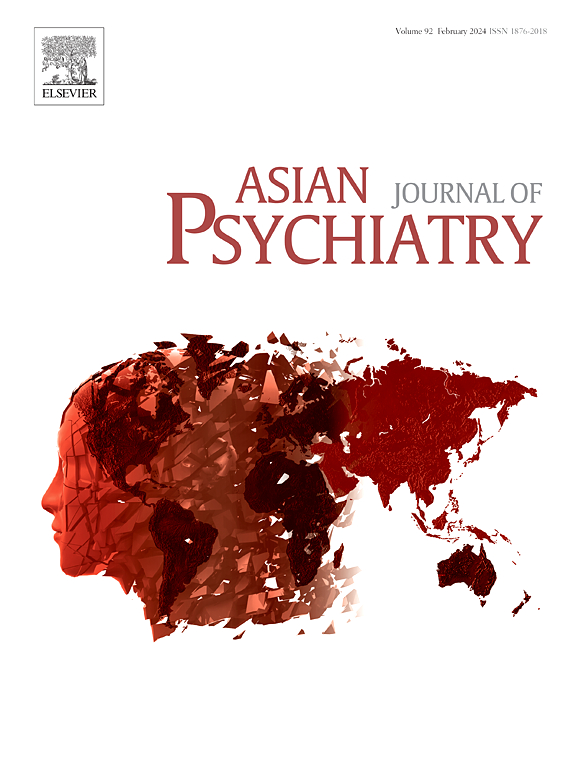Prediction of treatment efficacy in the suanzaoren decoction and estazolam for chronic insomnia disorder, along with brain function and cognitive changes before and after treatment, and potential gene expression profiles
IF 3.8
4区 医学
Q1 PSYCHIATRY
引用次数: 0
Abstract
Objective
This study compared the brain function changes in chronic insomnia disorder (CID) before and after treatment by suanzaoren decoction (SZRD) and estazolam, to reveal their effects in cognition improvement, and to explore the potential genetic basis underpinning the ReHo changes in CID.
Methods
We recruited 54 healthy controls (HCs) and 82 patients diagnosed with CID. All patients conducted clinical evaluation and fMRI scanning at baseline and after SZRD or estazolam treatment for six weeks. We used the mixed-effects model analysis to assess the pharmacological treatment response. Machine learning and transcriptome-neuroimaging spatial correlation analysis based on ReHo were presented to forecast therapeutic response and gene profiles.
Results
Compared to HCs, CID patients exhibited altered ReHo values in the right inferior parietal gyrus, left posterior cingulate cortex, left superior parietal gyrus, and left precuneus. Both the SZRD and estazolam groups demonstrated improvement in sleep duration and efficiency. Compared to the baseline, the SZRD group presented decreased ReHo value in the left supramarginal gyrus, increased ReHo value in the right middle occipital gyrus (MOG) and increased CoHe-ReHo value in the left MOG. The estazolam group showed no changes. The machine learning model fit the samples well, with predicted changes in PSQI and ISI scores positively correlated with actual changes. Additionally, genes associated with the imaging results were identified.
Conclusions
SZRD can improve CID symptoms and present advantages to cognitive function. Abnormal ReHo changes may serve as imaging markers for CID and predict drug efficacy and gene expression profiles related to CID.
预测酸枣仁汤联合艾司唑仑治疗慢性失眠症的疗效,以及治疗前后脑功能和认知的变化,以及潜在的基因表达谱
目的比较酸疮人汤与艾司唑仑治疗慢性失眠症(CID)前后脑功能的变化,揭示其对认知改善的作用,并探讨CID中ReHo变化的潜在遗传基础。方法我们招募54名健康对照(hc)和82名诊断为CID的患者。所有患者在基线和SZRD或estazolam治疗6周后进行临床评估和fMRI扫描。我们使用混合效应模型分析来评估药物治疗反应。采用机器学习和基于ReHo的转录组-神经成像空间相关分析来预测治疗反应和基因谱。结果与hc相比,CID患者右侧顶叶下回、左侧扣带回后皮层、左侧顶叶上回和左侧楔前叶的ReHo值发生改变。SZRD组和estazolam组均表现出睡眠时间和效率的改善。与基线相比,SZRD组左侧边缘上回ReHo值降低,右侧枕中回(MOG) ReHo值升高,左侧MOG CoHe-ReHo值升高。艾司唑仑组没有变化。机器学习模型很好地拟合了样本,PSQI和ISI分数的预测变化与实际变化正相关。此外,还鉴定了与成像结果相关的基因。结论sszrd能改善CID症状,对认知功能有改善作用。ReHo异常变化可作为CID的影像学标志物,预测CID的药物疗效和相关基因表达谱。
本文章由计算机程序翻译,如有差异,请以英文原文为准。
求助全文
约1分钟内获得全文
求助全文
来源期刊

Asian journal of psychiatry
Medicine-Psychiatry and Mental Health
CiteScore
12.70
自引率
5.30%
发文量
297
审稿时长
35 days
期刊介绍:
The Asian Journal of Psychiatry serves as a comprehensive resource for psychiatrists, mental health clinicians, neurologists, physicians, mental health students, and policymakers. Its goal is to facilitate the exchange of research findings and clinical practices between Asia and the global community. The journal focuses on psychiatric research relevant to Asia, covering preclinical, clinical, service system, and policy development topics. It also highlights the socio-cultural diversity of the region in relation to mental health.
 求助内容:
求助内容: 应助结果提醒方式:
应助结果提醒方式:


